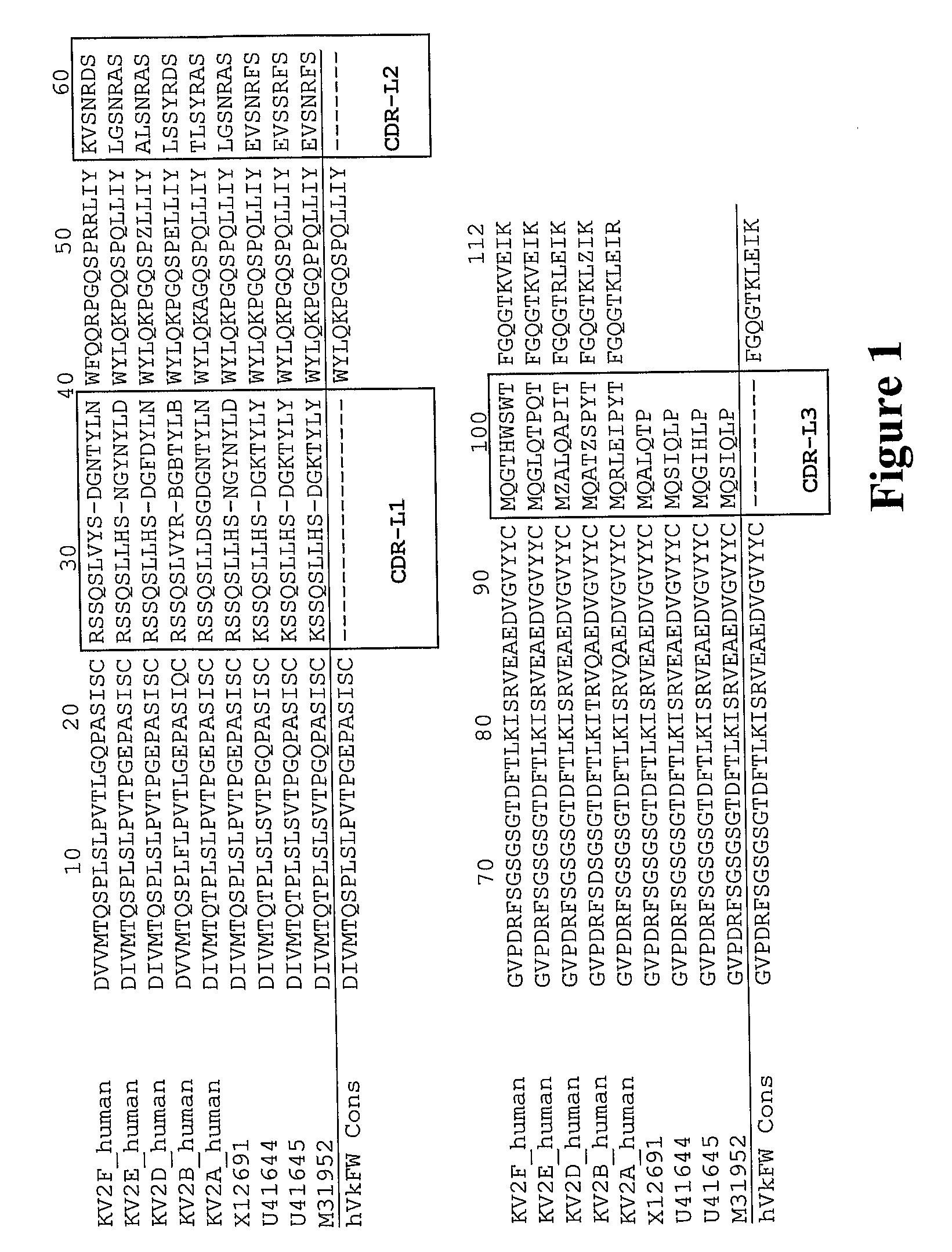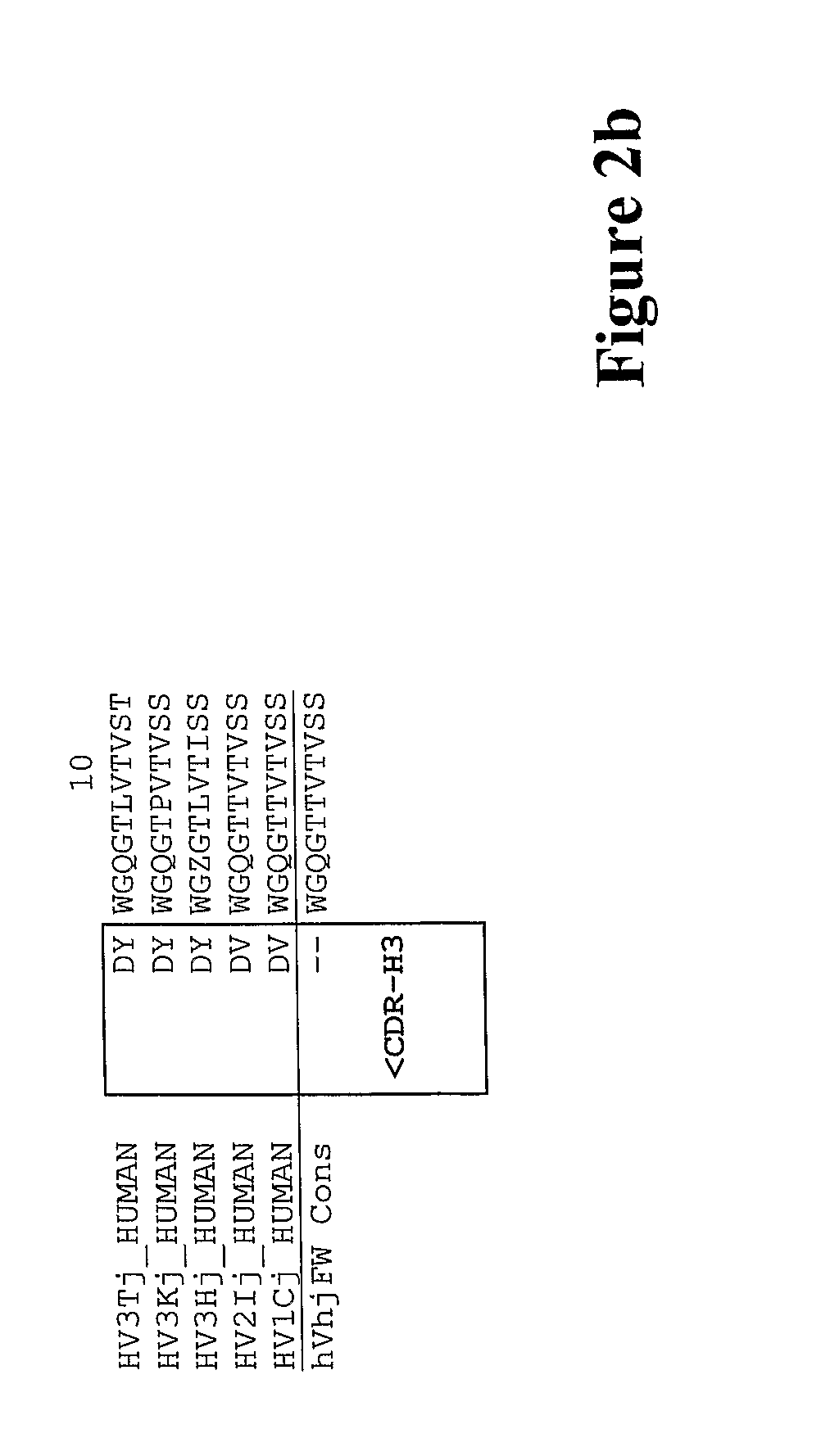Humanized anti-C5aR antibodies
a technology of humanized antibodies and anti-c5ar, applied in the field of humanized antibodies, can solve the problems of loss of antigenicity, human immune system may generate its own antibodies, and researchers in the art of humanizing antibodies have struggled to characterize appropriate guidelines to reliably produce humanized antibodies
- Summary
- Abstract
- Description
- Claims
- Application Information
AI Technical Summary
Benefits of technology
Problems solved by technology
Method used
Image
Examples
example 1
Humanization Process
Defining CDR and Framework Residues
[0322]The CDR and framework regions of an antibody have usually been defined according to various numbering schemes such as Kabat, Chothia or IMGT (ImMunoGeneTics information system® http: / / imgt.cines.fr). The Kabat definition is based on sequence variability and is the most commonly used. However, the CDRs for a given antibody as defined by Kabat are not necessarily identical to the CDRs defined by the other numbering systems. The CDRs defined by two numbering systems may overlap, or one may extend a few residues either side of the other.
[0323]The inventors used a combination of the Kabat and IMGT numbering systems to define the CDRs and framework regions in the variable (V) domain. The inventors wanted to maximise the extent of the mouse CDR sequences that were grafted into the human framework in order to preserve the structure of the antigen-binding pocket. So, the C5aR antibody CDRs included all residues classified as CDR by...
example 2
Expression and Production of Humanized Antibodies
Cloning Antibody Variable Region Genes into Vectors with Constant Region Gene
[0362]The heavy and light chain variable amino acid sequences were designed as described above. To produce antibodies containing these domains a DNA sequence encoding each variable region was synthesized (Genescript Corp.). EcoR1 and HindIII sites were added at the 5′ or 3′ end to facilitate cloning into the vector pUC18. In addition, the light chain variable gene had unique BsmB1 restriction sites at each end. The heavy chain gene had a BsmB1 site at the 5′ end and an Nhe1 site at the 3′ end.
[0363]To construct a full-length antibody gene a variable region gene was subcloned into a vector encoding a secretion signal and the constant domain. For the light chain, this vector contained the secretion signal sequence and the human constant kappa (Cκ) region gene separated by two unique BsmB1 sites. The heavy chain vectors contained the secretion signal and a human...
example 3
Binding Studies with Humanized Anti-C5aR Antibodies
[0371]To characterise the binding kinetics of the humanized anti-C5aR antibodies to the human C5a receptor (hC5aR), two types of binding studies are described in this example. The first compared the binding of antibodies and C5a to human C5aR in competitive-ligand binding assays. The second involved saturation binding in cells expressing human C5aR.
A. Humanized Anti-C5aR Displace C5a Binding to C5aR—Competition Ligand Binding Assay
[0372]The ability of humanized Abs to inhibit 125I-labelled C5a binding to L1.2 cells transfected with hC5aR gene or human neutrophils was tested as described below. Recombinant human C5a was obtained from Sigma Chemical Co. (St. Louis, Mo.). 125I-Bolton-Hunter-labelled complement C5a was purchased from NEN-Dupont (Boston, Mass.), with a specific activity of 2200 Ci / mM. Briefly, L1.2 / hC5aR stable transfectants were grown for several days prior to an experiment then treated overnight with 5 mM butyric acid ...
PUM
| Property | Measurement | Unit |
|---|---|---|
| concentration | aaaaa | aaaaa |
| concentration | aaaaa | aaaaa |
| concentration | aaaaa | aaaaa |
Abstract
Description
Claims
Application Information
 Login to View More
Login to View More - R&D
- Intellectual Property
- Life Sciences
- Materials
- Tech Scout
- Unparalleled Data Quality
- Higher Quality Content
- 60% Fewer Hallucinations
Browse by: Latest US Patents, China's latest patents, Technical Efficacy Thesaurus, Application Domain, Technology Topic, Popular Technical Reports.
© 2025 PatSnap. All rights reserved.Legal|Privacy policy|Modern Slavery Act Transparency Statement|Sitemap|About US| Contact US: help@patsnap.com



